This is the single biggest source of enquiries from readers of this website: how do I get rid of such-and-such a stain? This page aims to look at how some of the most common culprits are dealt with.
The white, powdery "stain" known as efflorescence is dealt with on a separate page and there is a further page that gives more in-depth consideration to Cleaning Paving.
And the circular marks sometimes seen on sandstone laid on mortar spots (shown opposite) have also been given a whole page of their own to explain what's happening - Reflective Staining
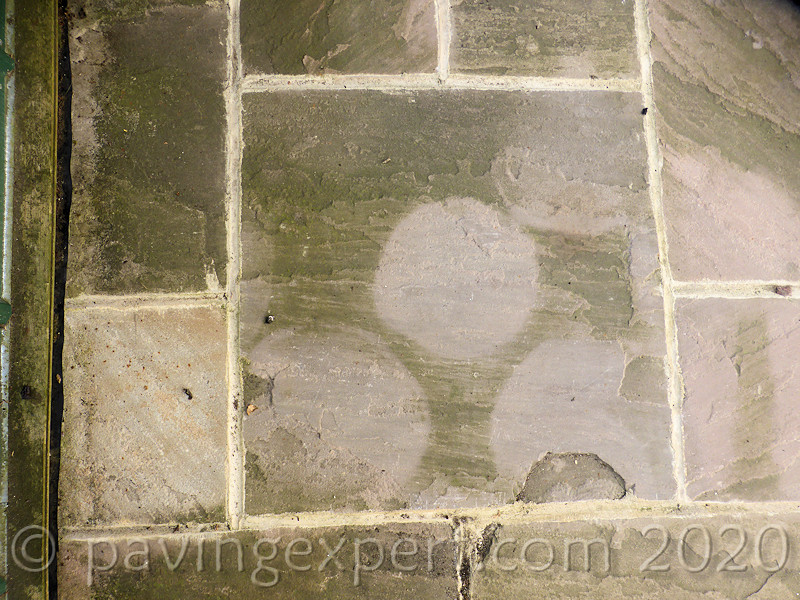
Here are our tips for removing the most common stains...
Cement, Mortar, Concrete:
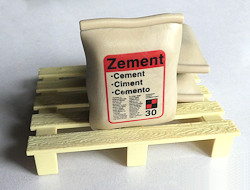
The cause of more enquiries about cleaning than any other stain, and most of the stains originate with DIYers with shaky-hand syndrome when pointing, or incompetent contractors who either don't know how to point or just don't give a #&*$!
There is no easy way to remove cement staining and with light hazing which occurs after some attempts at slurry or dry grouting, it's often best to leave it to time and weather, but when this isn't an option, the following may help....
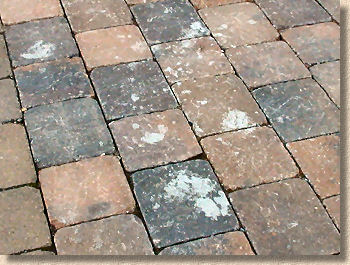
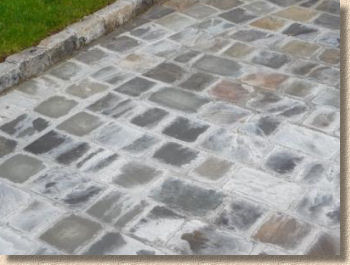
There are two stages to removing cement-based stains from paving... Removal of as much of the cementitious material as possible by using, for example, a hammer and bolster to chisel off the offending spots of material, fondly referred to as 'snots' in the building trade. Care is required to prevent accidental marking or scratching of the paving.
Scrubbing with a wire brush may remove most of any material remaining following initial scraping/chiselling and with care, this should not inflict any long-term damage to the paving. The chiselling and scrubbing process may be all that is required to remove the worst of the stain. Natural weathering can eliminate, or render inconspicuous, any residual minor staining.
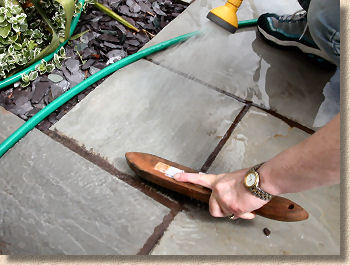
For heavy staining, or where a large area is affected, sand or grit blasting is a realistic option for suitable types of paving. Blasting will remove extraneous material from the surface but will simultaneously abrade any of the paving that isn't covered by cement or mortar,so this is a technique that is best suited to natural stone. It is only occasionally suitable for pressed concrete products (flags, kerbs, block pavers) and almost never appropriate for wet-cast concrete paving.
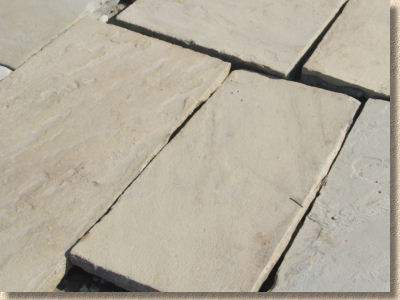
With the advent of smaller, portable blasting kit, some specialist contractors are willing to clean areas of, say, under 15m² for a couple of hundred quid (northern England prices -probably not applicable in that London). Obviously larger areas cost more, but for two hundred quid, clean paving worth in excess of 400 quid in terms of replacement (27 quid/m²), is perfectly possible.
In the photie above, old, reclaimed yorkstone flags from the streets of East Lancashire have been brought up like new by blasting with grit to remove all dirt and surface staining.
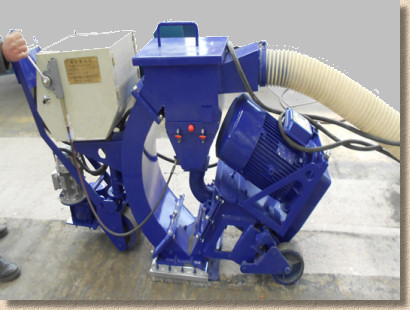
2 - Chemical action
This should only be undertaken on minor stains or if the efforts of the mechanical cleaning described above have left an undesirable or unsightly stain.
The chemical cement stain removers sold by builders' merchants contain an acid that reacts with the cementitious material, breaking it down and enabling total removal by repeated chemical treatment and scrubbing with a wire brush. Consequently, exceptional care is required.
When used to clean concrete flags or concrete blocks, the acid will also attack the surface of the paver, eating away at the uppermost surface of the unit. The same holds true for natural limestone (including some bitmacs) or travertine and marble used for paving.
The action of the acid must be tested on a small, inconspicuous area of the pavement prior to wider use. Some pavers can drastically, and irreversibly, change in appearance when treated with acid. This is particularly true of some of the imported flags and setts currently on the market.
If in doubt, leave it! It may be easier to replace the stained paving, assuming it is constructed from small elements, such as blocks, bricks or flags.
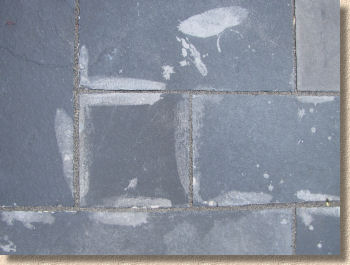
Protective gloves, clothing and most importantly, eye protection MUST be worn when using these acid-based cleaners. Read the manufacturer's instructions thoroughly. We dilute most acid cleaners to a strength not exceeding 5% acid to prevent serious discolouration or 'burning' of the paving. Some cleaners may already be diluted to this concentration - read the packaging.
Thoroughly wet the affected surface with clean water before applying any acid or cleaner. Apply the acid/cleaner as directed in the manufacturers instructions, and leave it to work for 5-10 minutes. We use an old paintbrush dipped in the acid cleaner to treat small areas, but for larger areas, it's nearly always better to treat the whole of the tainted unit, be it a block, a sett or a flagstone, rather than treat individual spots.
For larger areas, choose a dull or cloudy day to prevent the area being dried too quickly by the sun and be sure to pre-wet the area with water to prevent the acid being absorbed by thirsty paving. Scrubbing with a wire brush a few minutes after applying the acid may help to loosen or remove the cementitious material.
After each and every treatment, wash down with clean water and allow to dry before inspect and assessing the results. Repeat if necessary, but no more than is absolutely essential.
Oil:
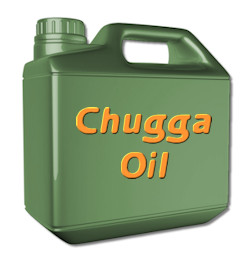
This includes most fuel stains, such as petrol, diesel, paraffin, thinners, lubricating oil, WD40 and the like.
There are a number of proprietary oil-stain removers available, but we have not yet found one supplied via the DIY sheds that works well and removes all of the stain. However, some of the commercial Oil Removing and cleaning agents supplied by specialist construction chemical companies, can remove most, if not all, of the stains.
Previously, we've had good results using Resiblock OR , as part of the Driveway Refurbishment Project
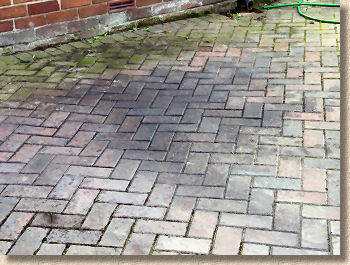
Prevention is better than cure, so put a cardboard or wooden 'drip tray' underneath any leaky engines. Note that tarmacadam will degrade if contaminated with oil or a thin, oil-derived product such as petrol, diesel or hydraulic/brake fluid. This damage can not be treated. You may have to repair or replace seriously affected areas.
The sooner an oil stain is treated, the more likely it is to be removed. Use a cloth to soak-up any oil droplets on the surface, but don't smear or rub the oil into the surface. Fresh oil stains can be soaked up by proprietary absorbent materials or even some of the clay-based cat litters, cornflour or talcum powder. Any residue remaining after treating with an absorbent agent can sometimes be removed or ameliorated by scrubbing with a detergent and brush before washing down with water. It may take several attempts for this to work. Clean oil will generally soak into the paving and there will be little evidence of its presence after a few weeks. Dirty oil can be very difficult, if not impossible to completely remove.
For more stubborn stains, you could use a degreasing agent or engine cleaning fluid such as Gunk, but always test a small inconspicuous area first for adverse reactions.
If the stain is proving impossible to shift, consider replacing the contaminated area of paving.
For cleaning oil from plain, trowelled concrete:
Here are some tips we've picked up from elsewhere for cleaning concrete. These methods should not be used on coloured, or imprinted concrete, or on concrete pavers, or tarmacadam.
- Mix 1 measure of trisodium phosphate with 6 measures of water. Daub this over the stain with a clean, old paintbrush and allow the goo to dry completely before scraping off the dried paste, which should, hopefully, bring most of the oil with it. Rinse the concrete surface and scrub vigorously with a stiff brush and clean water.
- Prepare a solution of 5% sodium hydroxide (caustic soda - NaOH). Daub it over the oil stain using an old paintbrush and allow it to dry for at least 24 hours. Rinse and scrub with clean water, then repeat as required.
- Paint white spirit or turps over the stain. Let the solvent evaporate for at least one hour before rinsing with hot, soapy water. Repeat as required.
Rust:
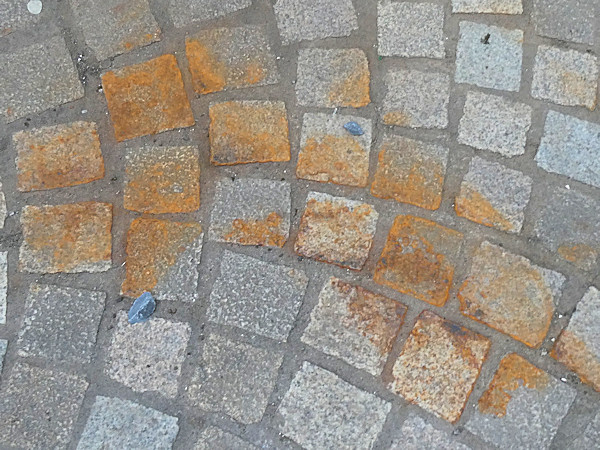
Rust stains arise from water running over metal fixtures and fittings then depositing iron particles on the paving and/or from the oxidation (rusting) of iron-rich compounds in the aggregate of the paving. There's also a danger of accidental staining when weed- and mosskillers containing ferric sulphate are applied to lawns and gardens next to paths, patios and driveways.

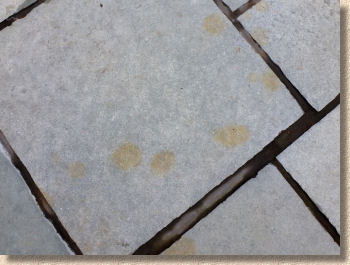
Rust stains are probably the most difficult to remove from most types of paving. Many of the dyes used to colour concrete paving are based on iron oxides, so many chemical agent may affect both the rust and the dyes. The 'patio cleaners' sold at the DIY sheds are based on a hydrochloric acid, and these usually have no minimal effect on rust, and occasionally the stronger acid dilutions can sometimes make the stains darker.
Acid warning:
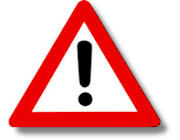
Use of strong acids on some imported sandstones and most limestones (which includes travertine and marble) can not be recommended. A number of imported materials display an adverse reaction to acids and the resulting damage can (and often does!) appear far worse than the original rust stain.
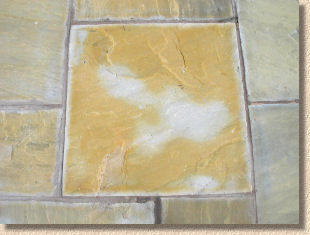
Check and double check any so-called rust remover or patio cleaner for acids before using.
Chemical options:
Due to enormous differences in the type, nature and porosity of any substrate, there are a number of possible chemical 'solutions' that may work. It should be noted that just because a particular 'solution' works well on, say yorkstone flags, that does not mean that it will work on imported stone, or on concrete flags. Similarly, any particular solution may have different effects on wet-cast and pressed concrete flags. Whatever is used, it's best to try it out in a small, discreet area first, as it's often impossible to predict just how any of these will react with any given stone or concrete.
- Lemon Juice - genuine lemon juice, fresh from a lemon, not from a bottle or a plastic imitation lemon. Squeeze directly onto the stained area, allow it to react for 5 minutes or so but don't allow it to dry out. While still wet, scrub the stained area with a nylon/polypropylene bristled brush (an old toothbrush is ideal), working the lemon juice into the surface of the paving. Wash off with plenty of clean water after 5 minutes and repeat as necessary.
- Vinegar - use a clear or white vinegar (spirit vinegar) rather than a coloured vinegar (malt or balsamic). Some readers of this site have reported that cider vinegar gives good results on some concrete surfaces. Use in exactly the same way as described above.
See Photo results below....
- Oxalic Acid - nasty stuff, as it's highly toxic, and it's not easy to find. It's more commonly used in the woodworking trades to bleach or whiten wood, but it is quite effective at removing heavier rust stains from concrete and some types of stone. It may come as a proprietary "rust remover" in which case you should follow the manufacturer's instructions to the letter. The efficacy of these products is highly variable and they MUST be tested on an inconspicuous area prior to use to ensure that the paving is not damaged or discoloured by their use.
Proprietary rust removers such as RCI and Bero are very good * on the right substrate *. RCI, in particular, seems very good on crystalline stone (eg: granite) and uncoloured concrete.
General purpose concrete cleaners may also help to remove rust stains, but again, they are incredibly variable in effect, and it might be as well to use just a simple detergent and hot water.
Site User, PeteUK, a contributor to the Brew Cabin discussion forum, tried using a white vinegar to remove rust stains left behind after he had temporary scaffolding erected at his home.
The footplates supporting the uprights should have been placed on timber pads to protect the riven-effect concrete flagstone paving from both rust and potential scratches, but somehow that got missed, and the result was unsightly orange-brown markings on his patio.
He took 'Before' and 'After' photies to show what happened....
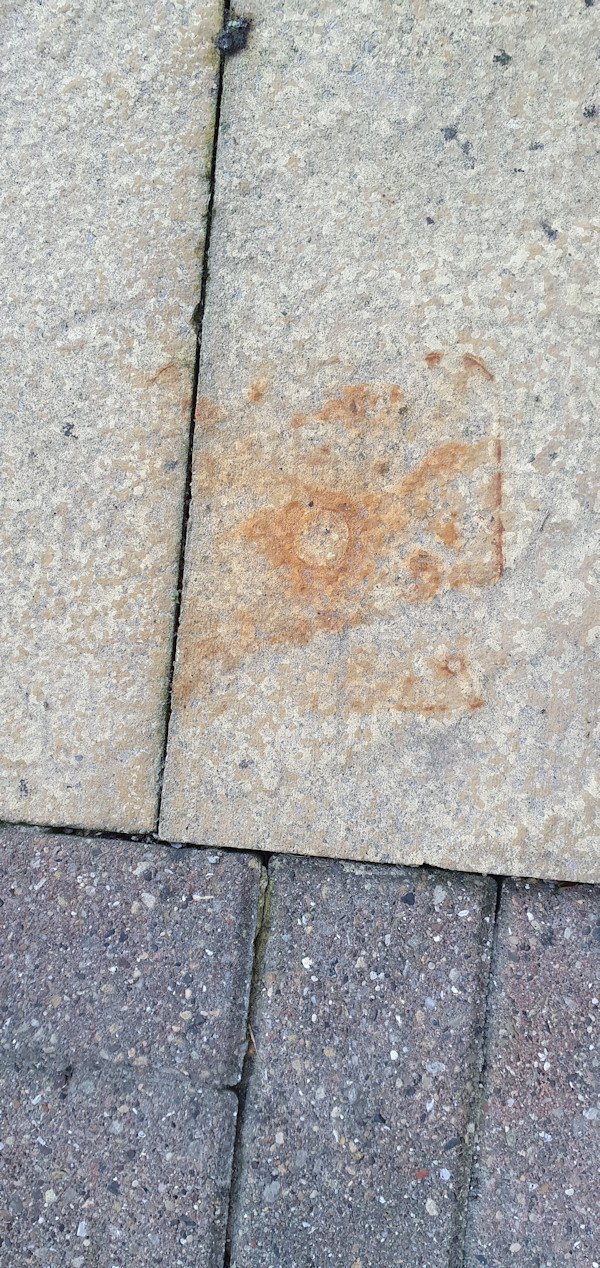

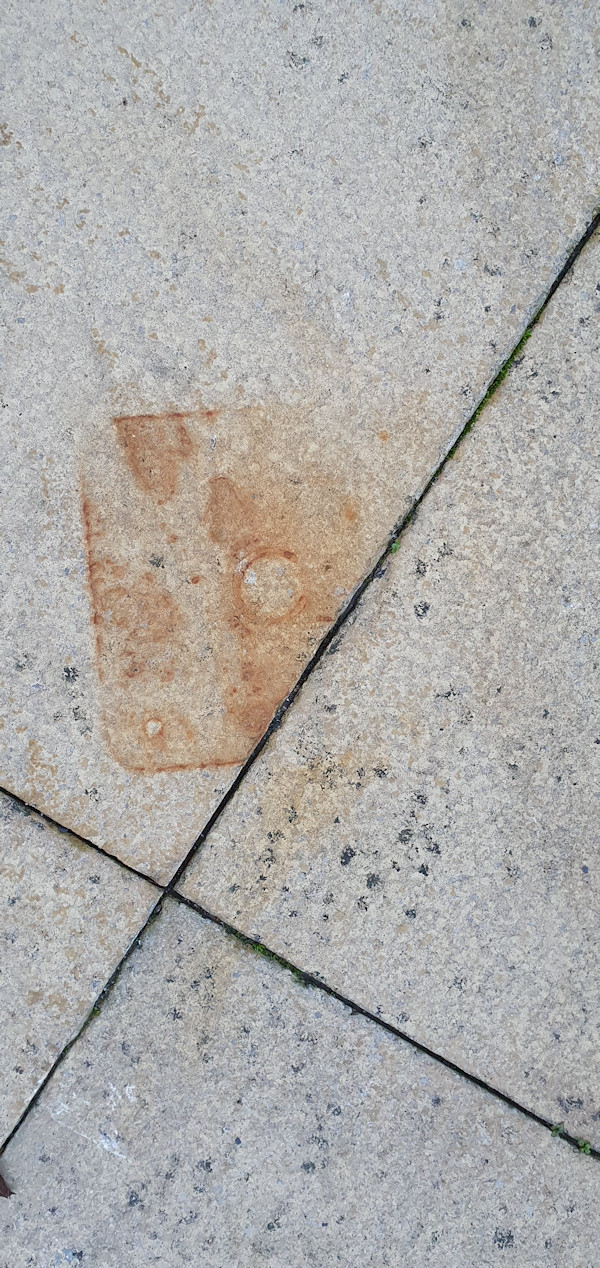
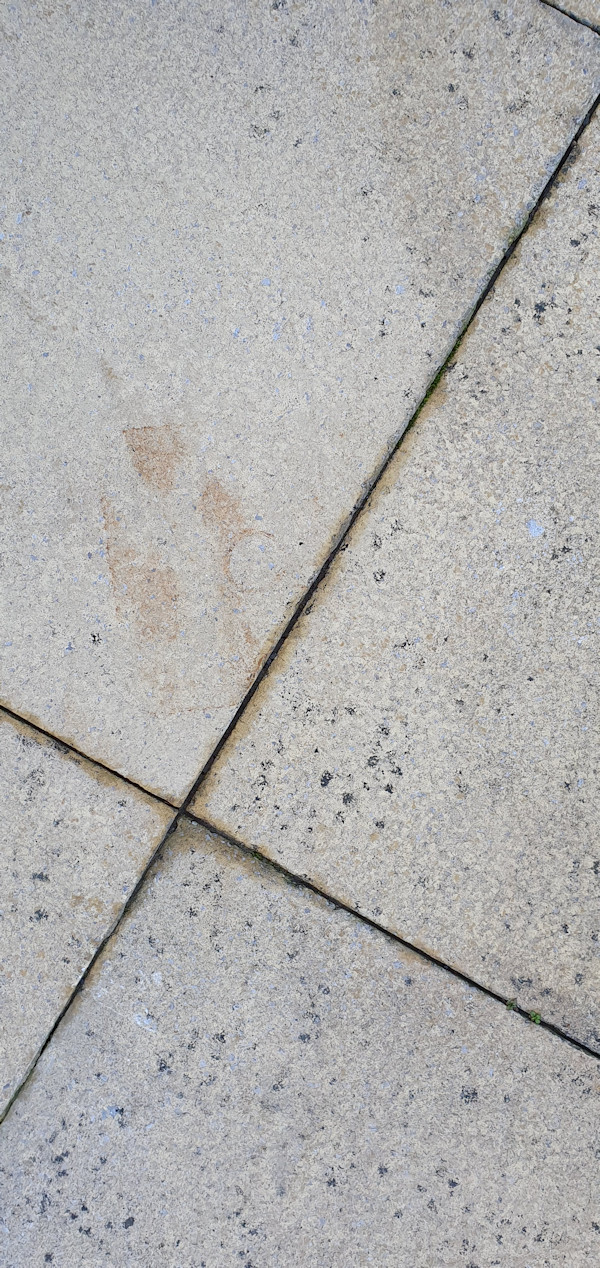
It's fairly obvious there is some improvement, but it's not 100%. PeteUK did try repeated applications, and, bit by bit, it got better and better, but there will be some stains, and some substrates, where the vinegar on its own is not quite enough.
You can read more about how PeteUK set about the task, what he used, how he used it, and how he thinks it worked for him, in the thread to which he originally posted.

There are ways and means that may help with stains caused by acid or rust in general. They're not infallible, but they could be worth a try..... read more.
Mechanical options:
All this leaves mechanical action as the only non-chemical remedy; vigorous scrubbing with a wire brush can sometimes remove the worst of the staining, as can 'buffing', a process where a hard stone or abrasive is used to 'sand down' the surface of the paving, removing the rust, and revealing a clean surface beneath.
See also the comments above regarding shot/sand/grit blasting
Final word:
As ever, prevention is better than cure. Although rust staining does not pose a threat to the structural integrity of the paving in the way that oils do to tarmacadam, it can be unsightly and detract from the aesthetics. Removal of rust sources and/or use of drip trays will keep most of the stains off the pavement. If using a mosskiller, then ensure any adjacent surfaces are covered and protected.
Algae, Lichens and Mosses:

Most pavements that are not frequently trafficked eventually develop colonies of mosses, lichens, fungi and algae over time, particularly in the predominantly damp climate we have in the British Isles. Again, prevention is better than cure, and regular aggressive brushing with a stiff-bristled broom and/or application of a general purpose weedkiller such as Glyphosate 2 or 3 times per year will keep colonisation to a minimum, but can never completely prevent it.
Proprietary fungicidal washes are available from Garden Centres and these usually need to be applied during dry weather, allowing a few days following application for the fungi to be killed and dried in the sun, before removal by simple brushing.
Heavily affected areas are best scraped clean with a shovel or a garden hoe and the detritus removed. A stiff brush will remove the residual loose material and then the pavement can be washed down, sloshing the area with bucketfuls of water, spraying with a hose or, for best effect, cleaning with a power washer . Detergents added to the water can help, and, it has been claimed, addition of Jeyes Fluid will deter the vegetation from returning for a limited period.
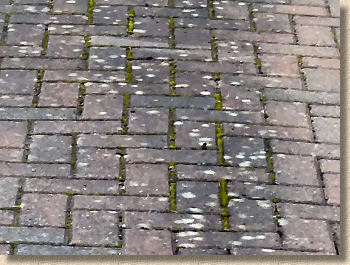

Algae and lichens have caused much trouble for many owners of Indian sandstone patios and driveways resulting in high levels of enquiries to this website. Consequently, a separate FAQ which looks at how best to manage infestations has been created.
Beer, Wine and Soft Drinks

Patios are meant to be used to enjoy the garden and that enjoyment is often enhanced with a glass of wine, can of beer or bottle of pop. Inevitably some spillages occur and they should be cleaned at the first opportunity. Hot, soapy water is usually sufficient to remove these sugar-rich stains. Particularly stubborn stains, such as red wine, may be removed by washing with a weak solution of household bleach (Sodium hypochlorite), but test a small area first.
Chewing Gum:
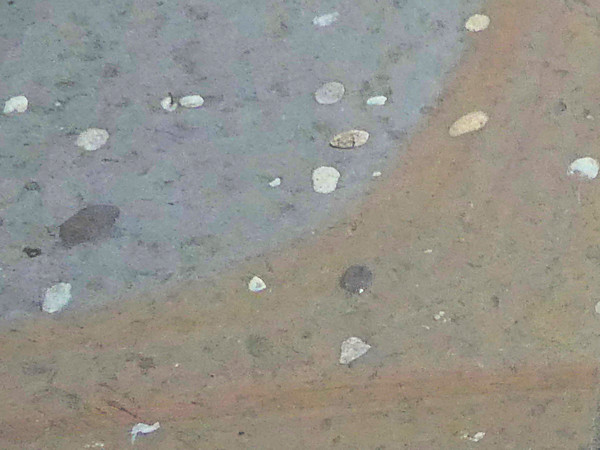
Not usually a problem on residential paving, chewing gum is the curse of the pedestrianised shopping centres and some councils employ specialist cleaning staff to keep town centres clean and gum-free. There are proprietary gum-removing and gum-dissolving agents available from cleaning supply companies, although they tend to be quite expensive. Individual 'blobs' can be scraped off the pavement, but this usually leaves some of the gum behind. One successful way of removing gum completely is to use a freezing agent to solidify the gum completely, making scraping more effective. These freezing agents, available from cleaning supply companies, are usually in aerosol form and are sprayed directly onto the gum, allowing a few seconds to take effect before removal.
There are also a number of specially developed machines that can be used to remove chewing gum from many types of surfaces, including all sorts of paving. The system uses high-temperature, low-pressure steam in conjunction with a non-caustic biodegradable cleaning agent to heat and dissolve the gum, which is then scrubbed with an integral brush unit to reduce the sticky residue to a powder that can be washed away with a hose or pressure washer.
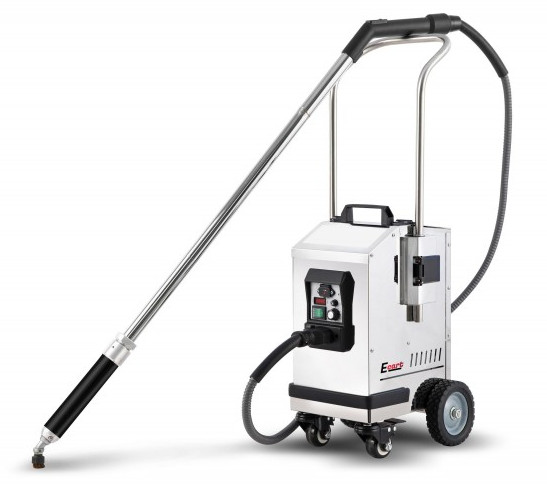
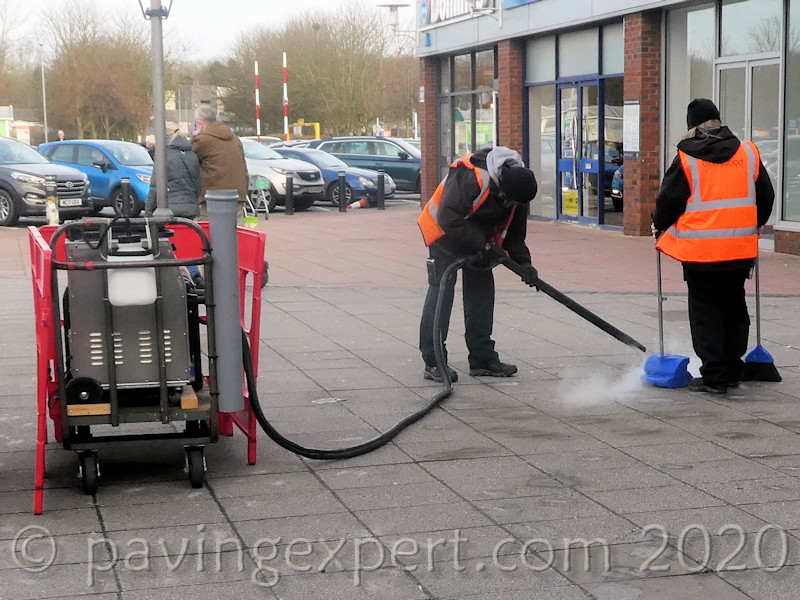
Liz Baker from Northumberland offers the following tip:
To remove chewing gum try a small amount of fairy liquid and enough salt on the top to soak up the fairy liquid. Leave for 5 minutes, gently rub it into the chewing gum and the whole lot should scrape off. No idea why it works but it does. It's good for carpets as well.
Paint:
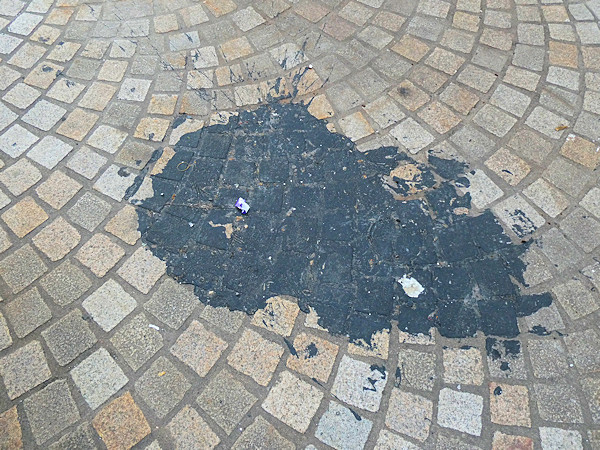
Paint stains are treated differently depending on how fresh the stain is.
New still-wet stains are best absorbed, not wiped, by a cloth or kitchen roll, and then scrubbed vigorously with hot-water and a detergent. Do NOT use thinners, turps, white spirit or any other solvent as they will serve only to carry the paint deeper into the paving or spread it over the surface.
Older, fully dried stains can be scraped off the pavement and the residue removed with paint stripper. On suitable surfaces, the careful and sparing use of a blow torch may help soften the dried paint, but avoid using heat on macadam surfaces, as the binder (tar or bitumen) may burn. With stone or concrete surfaces, careful application of heat a little at a time may help but prolonged, direct application can cause the surface to shatter or spall, sending dangerous shards of paving flying in all directions, so wear safety goggles and proceed wiuth caution.
Stripper/solvent should not be used on tarmacadam or other bituminous surfaces, as the paint stripper can dissolve the binder. In these situations, it's often easier to 'touch-up' small stains with a matt black paint.
Barbecue Fat:
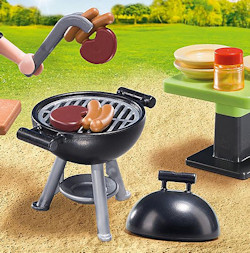
Another curse of garden paving are the small fat splashes that build up around a barbecue. As with the drinks stains discussed above, they should be cleaned as soon as possible with hot, soapy water. Most will naturally degrade over time, but when barbecues are a regular occurrence they can build up and become dangerously slippery if not regularly cleaned. For this reason, we always advise our clients to use a gravel surface around a barbecue, as this can be raked over to present a clean surface or easily replaced in cases of heavy fat contamination.
Where fats and other dirt has accumulated on a pavement surface, an 'all-round' specialist pavement cleaner such as Grundreiniger from Weiss will often help remove most, if not all of the contamination.
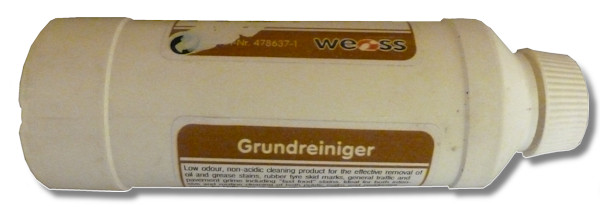
Berries and Fruit:

Berries, drupes and other soft fruit can stain paving when they fall from the parent bush, shrub or tree, and the visual distress can be increased when they first pass through a bird before being deposited on a pavement. When allowed to dry, the resulting stain can prove difficult to remove.
Cleaning Wiz Roger Oakley of R&A Pressure Washing Services Ltd has developed his own berry stain cleaning concoction over his many years of experience. He recommends obtaining a quantity of Sodium Hypochlorite (NaClO) at 13-15% concentration. This is NOT the same Sodium Hypochlorite sold as household bleach (although household bleach can be used if getting hold of the chemical proves difficult): it's the strong stuff sold for pool hygiene, so, one fairly reliable source of sodium hypochlorite is swimming pool maintenance suppliers. It's the stuff they use to chlorinate the pool water. Alternatively, janitorial suppliers may have stock.
The chemical must be in liquid form: granular Sodium Hypochlorite is sometimes used to treat swimming pools, but this form is not suitable for cleaning tasks. The concentration/strength of the product is critical; lower concentrations are usually cheaper per litre, but will often require more treatments to shift any staining, and so can be a false economy.
The other ingredient in Roger's Magic Jollop is a mild, non-oxidising shampoo. The purpose of the shampoo is to act as a surfactant, but it must be a non-oxidising otherwise it may compromise the action of the sodium hypochlorite. Roger suggests a Baby Shampoo, as these are usually the mildest and safest of all. It's worth pointing out that many supermarket own-brand baby shampoos are just as good, in this context, as more expensive named brands.
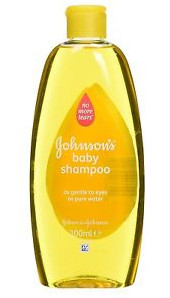
Lee Barrow of cleaning specialists Blast-Away based in Radcliffe near Manchester adds....
We use another surfactant called Lauryldimethylamine Oxide, Amine Oxide for short. It's a great surfactant and helps spread the 'Hypo' mix better and it's great for clinging to vertical surfaces.

Sodium hypochlorite is dangerous: it is corrosive and an irritant; it will burn skin; even minor splashes can damage eyesight, and so it is essential that full protective gloves and goggles are worn at all times when cleaning using this product. The liquid will also burn or kill plants and vegetation, so care must be taken when using in and around gardens.
It is important that the entire pavement is treated; this fluid may cause slight beaching or lightening of some surfaces, and therefore spot cleaning could result in the stain being replaced by patches of slightly paler surface. By cleaning the whole surface, any bleaching will affect all of the paving and not just individual spots.
Pre-wet the whole of the pavement with clean water. Before the surface dries, spray with the prepared cleaning fluid (or brush with the fluid) and use a stiff brush to gently scrub the whole surface.
The cleaning fluid needs to be left on the surface for 15-20 minutes and during that time, the surface must not be allowed to dry out. Mist with additional cleaning fluid or with clean water to prevent the paving from drying. Work the area(s) of staining with a brush, if necessary, but ensure the surface remain wet at all times. After the 15-20 minute cleaning period, the pavement should be washed down with clean water. Bear in mind that the cleaning fluid will harm or possibly kill vegetation so avoid washing off onto garden or lawned areas. Once washed off, the paving may be allowed to dry.
This treatment usually works with normal staining, depending on how you define "normal staining". Awkward or heavy staining may need two or three treatments, and in exceptional cases, it may be necessary to reduce the dilution of Sodium Hypochlorite to a ratio of 2:1 (2 litres of water to 1 litre of NaClO).
A further handy tip for heavy staining is to pre-wash the affected paving with "OxiClean", a product more normally associated with domestic laundry.
Sycamores and Maples:
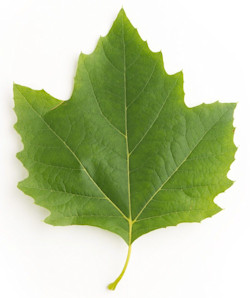
Sycamores are notorious for proving a home to creepy little aphids that excrete a sugar-rich goo that drips down onto whatever lies beneath. This goo is used as a food source by algae and bacteria which give it the distinctive black colouring.
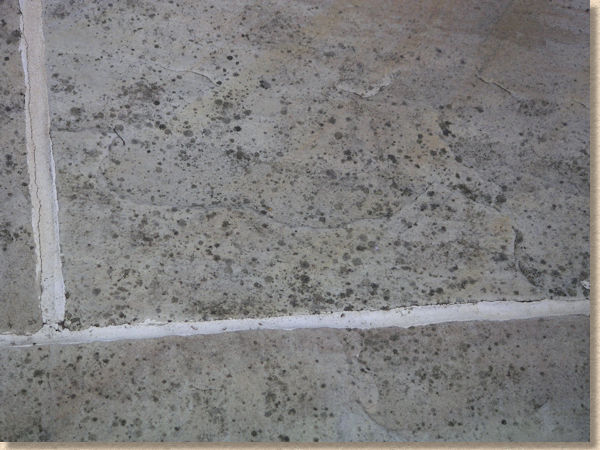
The stain is sometimes mistaken for a lichen, and it may well develop into a lichen given enough tie, but in the early stages, most commonly in Summer and early Autumn, it's basically just sugar and bacteria, so should be easier to remove.
And as it is largely sugar-based, Roger's ever versatile Magic Cleaning Jollop for imported sandstone paving usually deals with the stain but it can take repeated treatments. The longer you keep the treated area damp with the cleaning solution, the sooner it will shift.
Other Repair and Maintenance Pages
